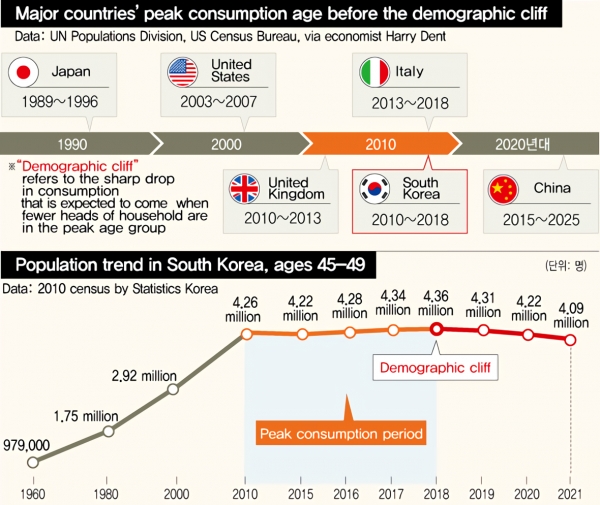
South Korea is rapidly approaching a “demographic cliff” as the country continuously suffers from a low birth rate and an aging population. Experts even suggest that the demographic cliff has already begun since 2018 when the country’s birth rate dropped below 1. The acceleration of this population drop is causing the government a plethora of problems, as most policies were based on a statistical analysis that the demographic cliff will not occur until around 2030. Statistics Korea (the national statistical office of Korea) and other ministries are scrambling to establish countermeasures; however, a fundamental solution is yet to be found.
The term “demographic cliff,” coined by American financial newsletter writer Harry S. Dent in his book The Demographic Cliff (2014), is an economics term that refers to the sharp drop in consumption that is expected to come when fewer heads of households are in the peak age group. The peak consumption age for South Korea is calculated to be from 45 to 49.
From an economic point of view, a demographic cliff leads to a consumption cliff. The devastating effect of a consumption cliff has already been demonstrated by the U.S. in 2007 and Japan since 1989. The U.S. consumption peak came in the years 2003 to 2007, just before the 2007-08 financial crisis (the United States subprime mortgage crisis) struck the world. For Japan, the period came between 1989 and 1996 and resulted in Japan’s long-term downturn. A similar scenario is expected to happen in Korea. According to statistics, Korea’s population aged 45 to 49 has peaked at about 4.6 million in 2017 and has declined to 4.5 million in 2019. It is predicted to fall below the 4 million mark by 2022. An overall population decline is likely to affect many domestic industries related to the growth of a person, especially childbirth, childcare, and education (including universities). The KB Financial Group Research Institute also showed its concern that it is “very likely that the steep rate of decline in the population aged 45 to 49 with the highest house purchasing ability will be a shock to the real estate market.”
Specific to Korea, the conscription system is also likely to be affected by the demographic cliff. The Ministry of National Defense has acknowledged a shortage of troops and reports that date back to as far as 2014 show that this shortage is causing many problems. To account for the loss in military force due to population decline, many experts and citizens suggest that the implementation of a volunteer military system or female conscription is necessary.
Current government efforts to combat low birth rate are being criticized as useless and ineffective. The Health and Welfare Committee has constantly extended the range and amount of childbirth grants; regardless of these efforts, surveys and statistics showed that monetary assistance had no significant effect on the declining birth rate. A more fundamental solution such as the reestablishment of domestic gender roles, labor, salary, and career-related revolutions, etc. is needed.
The French Baby Boom
France is one of the most successful nations to combat low fertility; France has consistently topped European rankings since the early 2000s. Its fertility rate in 2014 was 2.01. France’s success can be classified into two factors: getting women into work and ditching rigid family norms. Ined (French Institute for Demographic Studies) Demographer Laurent Toulemon explains that in countries such as France and Scandinavia “the family norm is much more flexible, with late marriages, reconstituted families, single parents, much more frequent births outside marriage and divorces than further south,” and “People are far less concerned about the outlook for the family [as an institution].” Also, contrary to the old perception that countries with high fertility were the ones where women did not usually go out to work, fertility in Europe is higher in countries where women go out to work, lower in those where they generally stay at home.
Ined have seen a steady stream of Korean policymakers and Japanese academics investigating the French example over the past 10 years. Demographer Olivier Thévenon mentioned that “in the past four or five years we have had over 10 Korean delegations.”
Korea must act swiftly as the demographic cliff crisis is imminent. Policies benchmarking successful countries such as France along with local modifications are necessary to tackle this problem.


